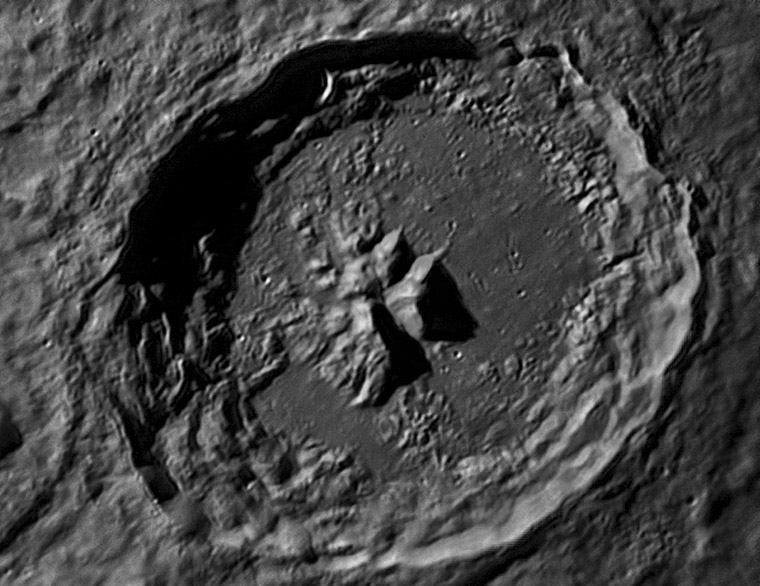Difference between revisions of "August 1, 2013"
| Line 6: | Line 6: | ||
<em>image by [mailto:aerts.leo@skynet.be Leo Aerts], Belgium</em><br /> | <em>image by [mailto:aerts.leo@skynet.be Leo Aerts], Belgium</em><br /> | ||
<br /> | <br /> | ||
| − | I don't like the [http://lpod. | + | I don't like the [http://www2.lpod.org/wiki/July_21,_2013 guy], but the crater is terrific. Theophilus is a large (100 km diameter) Copernicus style crater with classic complex features of terraced walls, large flat floor and massive central peaks. The smooth parts of the floor are not as smooth as the floor of [http://www2.lpod.org/wiki/July_31,_2013 Tycho] and there are a half dozen or more impact craters on Theophilus, both facts are evidence that Theophilus is older. That has been known since at least 1976 when Gerhard Neukum and Beate König did [http://articles.adsabs.harvard.edu//full/1976LPSC....7.2867N/0002867.000.html crater counts] for 21 young craters on Lunar Orbiter and Apollo Metric photos. Theophilus was found to be on the Eratosthenian side of the Copernican-Eratosthenian boundary, with the same crater count age as [http://www2.lpod.org/wiki/July_27,_2013 Langrenus]. Apparently no modern, LRO crater counts have been published yet. LRO high res images on Quickmap show that the smooth materials, undoubtedly impact melt, have been eroded down/modified so that they lack the sharp fractures and flow features of younger melt. This shows that melt deposits retain their gross morphological characteristics - their smoothness and occurrence in ponds outside craters - after the high res details are gone. A crater age dating scale probably could be developed based on the degree of fine scale roughness of impact melt. <br /> |
<br /> | <br /> | ||
<em>[mailto:tychocrater@yahoo.com Chuck Wood]</em><br /> | <em>[mailto:tychocrater@yahoo.com Chuck Wood]</em><br /> | ||
| Line 14: | Line 14: | ||
<br /> | <br /> | ||
<strong>Related Links</strong><br /> | <strong>Related Links</strong><br /> | ||
| − | <em>[ | + | <em>[[21st Century Atlas of the Moon|21st Century Atlas]]</em> chart 7.<br /> |
<br /> | <br /> | ||
<p><b>Yesterday's LPOD:</b> [[July 31, 2013|14 Inches of Tycho]] </p> | <p><b>Yesterday's LPOD:</b> [[July 31, 2013|14 Inches of Tycho]] </p> | ||
Latest revision as of 08:23, 28 October 2018
Smooth Floor Comparisons

image by Leo Aerts, Belgium
I don't like the guy, but the crater is terrific. Theophilus is a large (100 km diameter) Copernicus style crater with classic complex features of terraced walls, large flat floor and massive central peaks. The smooth parts of the floor are not as smooth as the floor of Tycho and there are a half dozen or more impact craters on Theophilus, both facts are evidence that Theophilus is older. That has been known since at least 1976 when Gerhard Neukum and Beate König did crater counts for 21 young craters on Lunar Orbiter and Apollo Metric photos. Theophilus was found to be on the Eratosthenian side of the Copernican-Eratosthenian boundary, with the same crater count age as Langrenus. Apparently no modern, LRO crater counts have been published yet. LRO high res images on Quickmap show that the smooth materials, undoubtedly impact melt, have been eroded down/modified so that they lack the sharp fractures and flow features of younger melt. This shows that melt deposits retain their gross morphological characteristics - their smoothness and occurrence in ponds outside craters - after the high res details are gone. A crater age dating scale probably could be developed based on the degree of fine scale roughness of impact melt.
Chuck Wood
Technical Details
July 27, 2013 at 3h31 UT. Celestron 14 with 2.5x powermate, dispersion corrector and redfilter
Related Links
21st Century Atlas chart 7.
Yesterday's LPOD: 14 Inches of Tycho
Tomorrow's LPOD: Plato in My Dreams
COMMENTS?
Register, Log in, and join in the comments.



